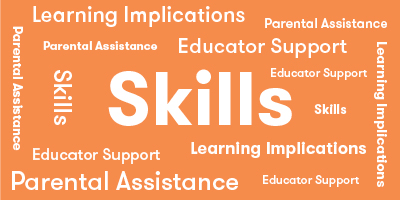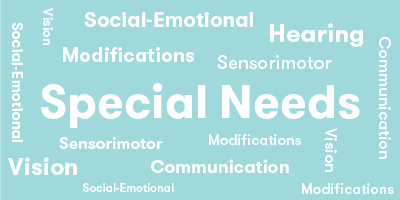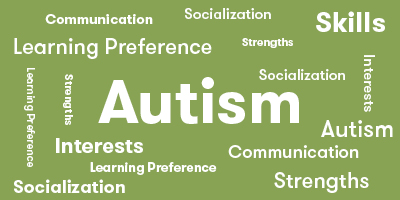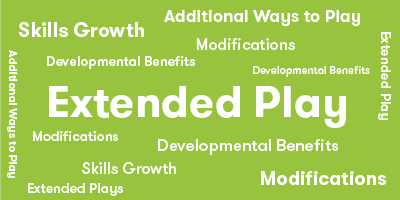





Collapsible content
You can play 15 to Zero with 2-6 players, ages 7 and up.
15 to Zero is good for developing Addition Skills as players try to match the numbers on their cards by creating the sums of the numbers on the dice.
15 to Zero also helps with Quick Thinking Skills as players see how fast they can create a match and get rid of their cards.
To set up the game, give each player one color set of Number Cards consisting of all fifteen cards numbered from 1 to 15.
Shuffle the six Special Cards and deal one card to each player. Put any remaining Special Cards back in the box.
After all the cards have been dealt, players should place their set of cards, including the Special Card, face down in a single pile in front of them.
To find out who goes first, each player takes a turn rolling all three dice. The highest sum begins the game.
Players take turns rolling the dice and matching their Number Cards to an individual number on a single die or the sum of two or more dice. The first player to get rid of their Number Cards wins the game.
To play, the starting player rolls all three dice. Each roll will result in seven values: the face value of each of the three dice, as well as the sums created by adding two or more of the dice together.
For example, if a player rolls a 2, 4 and 7, the possible values would be 2, 4, and 7 – the face value of the dice – as well as 6, 9, 11 and 13 – the sums that result from adding the various dice combinations together.
Once the starting player rolls the dice and says, “Go,” ALL players pick up their card sets, search through the Number Cards, and try to match their cards with any one of the seven values. When a match is found, the player lays down the matching card.
Each player may only play one card per turn, and no two players may play the same number card during a turn. If players play the same card consecutively, the last player to lay the card down must take it back and play another. If more than one of the same number cards are played at the exact same time then the players involved break the tie by shuffling the discard pile and drawing a card from the top of the pile. The player who draws the highest number card wins the tie and keeps their number card in play. The other players who tied try to play another card based on that turns roll.
When all players have played a card, the turn ends. Be quick or you may not be able to place a card during that turn if no matches remain available.
After all players who could play have played a card your turn ends. The cards that were played are discarded into the discard pile and players place their remaining cards in a single pile face down in front of themselves. Pass the dice to the player on your left and play continues clockwise.
Now, what about the Special Cards? A player may play a Special Card during a turn instead of a Number Card, but only ONE Special Card can be played per turn.
If a Switch card is played, the player shouts SWITCH! and each player draws a random card from the player to the left.
The Freeze card freezes any Number Card just played, and blocks the number during the next turn. With the Pick-up card, a player can make any other player pick up the top two cards from the discard pile, giving that player two more cards to get rid of.
The first player to discard all 15 cards from his hand wins, and the game is over.
With SimplyFun’s 15 to Zero you’ll spend the whole game doing addition, but it’s only when you have nothing that you win!


Core Standard*: Math
Math
- Operations and Algebraic Thinking
- Add and subtract within 20. Grade Level 2nd


Explore
What Does Child Do To Use Skill In The Game?
Players need to first examine the dice to see what values are represented and the examine their cards to look for matches.
How Parents Can Assist Learning
15 to Zero requires children to think about multiple value options, namely, single dice and adding 2 and 3 dice together. Parents can allow children to move the dice so they are in a line and oriented in the same direction. This will help children with adding.
Learning Implications and Educator Support
15 to Zero requires children to think about multiple value options, namely, single dice and adding 2 and 3 dice together. Educators can allow children to move the dice so they are in a line and oriented in the same direction. This will help children with adding.
Determine
What Does Child Do To Use Skill In The Game?
Players need to determine if they have a card that matches a value represented by the dice, or, if possible, will they play their Special Card.
How Parents Can Assist Learning
To help all the children playing, have the person who rolled the dice say all of the values aloud before players look at their cards. If a child cannot play a number card, ask if they want to play their Special Card provided they have not played it yet.
Learning Implications and Educator Support
15 to Zero requires children to think about multiple value options, namely, single dice and adding 2 and 3 dice together. To help all the children playing, have the person who rolled the dice say all of the values aloud before players look at their cards. If a child cannot play a number card, ask if they want to play their Special Card provided they have not played it yet.
Compare
What Does Child Do To Use Skill In The Game?
When playing 15 to Zero, players compare the dice values to the values on their cards.
How Parents Can Assist Learning
15 to Zero requires children to think about multiple value options, namely, single dice and adding 2 and 3 dice together. Parents can allow children to move the dice so they are in a line and oriented in the same direction. This will help children with adding.
Learning Implications and Educator Support
15 to Zero requires children to think about multiple value options, namely, single dice and adding 2 and 3 dice together. Educators can allow children to move the dice so they are in a line and oriented in the same direction. This will help children with adding.
Remember
What Does Child Do To Use Skill In The Game?
Players need to remember the different values represented by the dice.
How Parents Can Assist Learning
To help with memory, have the person who rolled the dice say all of the values aloud before players look at their cards. Saying ideas aloud helps reinforce short term memory, as does hearing the ideas. If children still have difficulty remembering the values, write them down on each turn so that children can read them when looking at their cards.
Learning Implications and Educator Support
To help with memory, have the person who rolled the dice say all of the values aloud before players look at their cards. Saying ideas aloud helps reinforce short term memory, as does hearing the ideas. If children still have difficulty remembering the values, write them down on each turn so that children can read them when looking at their cards.
Predict
What Does Child Do To Use Skill In The Game?
15 to Zero involves a little predicting as a Player considers what opponents may do in response playing the Pick-Up Special Card.
How Parents Can Assist Learning
No special adult support required.
Learning Implications and Educator Support
No special adult support required.
Plan
What Does Child Do To Use Skill In The Game?
15 to Zero involves a little planning as a Player considers think about when to play their Special Card.
How Parents Can Assist Learning
To help children plan, ask them to share different reasons and times they are considering to play their Special Card and what they think the effect will be. This requires playing non-competitively for the purpose of learning.
Learning Implications and Educator Support
To help children plan, ask them to share different reasons and times they are considering to play their Special Card and what they think the effect will be. This requires playing non-competitively for the purpose of learning.
Practice
What Does Child Do To Use Skill In The Game?
Each throw of the dice gives children practice with adding.
How Parents Can Assist Learning
Parents can allow children to move the dice so they are in a line and oriented in the same direction. This will help children with adding.
Learning Implications and Educator Support
Educators can allow children to move the dice so they are in a line and oriented in the same direction. This will help children with adding. Also, educators can use the 15 to Zero to teach concepts of Additive Identity Property, Commutative Property and Associative Property.
Solve
What Does Child Do To Use Skill In The Game?
This is the primary purpose of the game is for children to solve simple addition and match the results to their cards.
How Parents Can Assist Learning
Parents can allow children to move the dice so they are in a line and oriented in the same direction. This will help children with adding.
Learning Implications and Educator Support
Educators can allow children to move the dice so they are in a line and oriented in the same direction. This will help children with adding.
Review
What Does Child Do To Use Skill In The Game?
Players may review if encouraged. See How Parents Can Assist Learning and Learning Implications and Educator Support.
How Parents Can Assist Learning
If children are having difficulty, have them review the options with each throw of the dice. For example, if 2,5,6 are thrown, the child reads the single numbers, then says, 2+5 = 7; 2+6=8; 5+6=11. If a mistake is made, take the opportunity to find out how the child determined the answer and help them rethink the problem.
Learning Implications and Educator Support
For children who are practicing learning simple addition, have them review the options with each throw of the dice. For example, if 2,5,6 are thrown, the child reads the single numbers, then says, 2+5 = 7; 2+6=8; 5+6=11. If a mistake is made, take the opportunity to find out how the child determined the answer and help them rethink the problem.
*Data compiled from CCSSI ELA Standards, WA Science Standards, and Washington Social Studies Standards


Cognitive
Suggestions for How to Modify Play Experience
For children who are lower functioning adding three dice, particularly with higher numbers, may be too challenging. Start with rolling just two numbers and using cards up to 12 until the child's adding proficiency increases.
Omit the Special Cards as these may be confusing for children with cognitive challenges. Add them in one at a time, starting with the switch card, as this is the easiest. Then add in the Pick-Up card. The Freeze card is the hardest to understand, so add it last or omit it.
Communication
Suggestions for How to Modify Play Experience
Communication is not essential in the game. Encourage players to check each others addition, watch for duplicate Number cards, and comment on good moves made by other players.
Ask the players to read the Special Cards when they are used. Children who have difficulty initiating and carrying on a conversation may be able to read the cards as a beginning point for a social exchange among the players.
Sensorimotor
Suggestions for How to Modify Play Experience
Holding and manipulating 15 cards may be difficult for children with fine motor concerns. Make a card holder from a piece of stiff paper. Fold the long edge of the paper up about 1 inch. This will create a lip to hold the cards. Fold the remaining unfolded paper in half the opposite direction of the first fold. This will create a tent to support the cards.
Children with cerebral palsy may have difficulty controlling the dice. Use a plastic cup for throwing the dice if this is difficult for the child. The cup can just be turned over.
Social Emotional/Behavioral
Suggestions for How to Modify Play Experience
Children with low tolerance for frustration may become upset if they are not allowed to play a card when duplicate numbers are played. The game can be modified to avoid this potential. Take turns rolling the dice. Only the player rolling the die plays his/her number cards. This avoids the no duplicates rule and removes the stress of comparing which player used more cards on the same role, as is done in the regular rules.
Vision
Suggestions for How to Modify Play Experience
Children with low vision should be able to see the large size numbers on the cards. Give this child the purple set of cards, as the contrast between number and background is greater. A handmade card holder can also allow cards to be separated a little more, making them more visible. (Make a card holder from a piece of stiff paper. Fold the long edge of the paper up about 1 inch. This will create a lip to hold the cards. Fold the remaining unfolded paper in half the opposite direction of the first fold. This will create a tent to support the cards.) Special cards are harder to see, especially the explanation. Draw a symbol in black marker on each of the special cards to indicate the action needed. For example ⇔ for SWITCH, X for FREEZE, and ∇ for PICK-UP.
Hearing
Suggestions for How to Modify Play Experience
Hearing issues are only a problem when discussing the plays made by individual players. If all players cannot use sign language, use a white board to write correct responses or actions.
*Data compiled from CCSSI ELA Standards, WA Science Standards, and Washington Social Studies Standards


Autism Strengths & Interests
Short Summary of Strengths & Interests
- Is good at adding Can pay attention to what other players do
- Can pay attention to what other players do
- Likes to make matches based on numbers or visual details
Is good at matching visual items
Is This Game Appropriate? Yes
Description
Players will use both visual matching and amount matching skill in 15 to Zero. If a player has a card with the same value as one die, then the child can play that card to make a match. Also, if two or more dice add up to a card value (ex: 2 + 3 + 5, and the player has a 5 card), the child can place that card to make a match. Because acting fast is important, adults may need to slow the game play down a little to ensure that an autistic child has enough time to add up the dice and look for matches.
Has a good memory for sensory details, including visual, touch, taste and smell
This game is not appropriate
Has a good memory for words, phrases and dialouge
This game is not appropriate
Has a good memory for pictures, numbers and patterns
Is This Game Appropriate? Yes
Description
Children who have a good memory for numbers will be able to use those skills in 15 to Zero. The more players can remember the cards they have and the values of the dice, and recall addition facts, the faster they will play a matching card.
Likes to put things in order or a sequence
Is This Game Appropriate? Yes
Description
Adding the dice in 15 to Zero involves establishing four addition sequences on every turn. children with autism who enjoy sequencing and adding will hone those abilities playing the game.
Learns through visualizing or "replaying" actions in their mind
Is This Game Appropriate? Yes
Description
15 to Zero includes Special Cards that allow players to change the ordinary actions on a turn, such as requiring another player to pick up new cards or all the players to swap a card. Children with autism who are good at visualizing the effects of an action will do well at this aspect of 15 to Zero, but they may find changing the pattern of play to be challenging. Modification or elimination of these cards may be helpful.
Likes activities with rules, such as math and phonics
Is This Game Appropriate? Yes
Description
Children who like adding and following the rules will benefit from 15 to Zero. During each turn, the players will add dice together and then look to make matches with their cards. Additionally, the three Special Cards represent clear, simple rules the players can use to influence the game. Help children understand these Special Cards as additional rules, rather than a change to the rules, to help them tolerate the shift in play actions.
Is very concrete and literal
This game is not appropriate
Learns in small "chunks" (for example, phone numbers are 3 chunks of number xxx-xxx-xxxx that are combined together)
This game is not appropriate
Is good at nonverbal reasoning and logic
Is This Game Appropriate? Yes
Description
Reasoning with numbers involves understanding patterns and applying logic to the numbers provided to obtain an answer. In 15 to Zero, calculating values and using logic to make matches does not require verbalizing or writing down your reasoning. Therefore, children who are good at non-verbal reasoning will be able to use that ability to help win the game.
Likes spatial problem solving
This game is not appropriate
Can read well with good vocabulary, though may not fully comprehend content
This game is not appropriate
Likes to use and has good fine motor skill
Likes established routines or set ways of doing things
Is This Game Appropriate? Yes
Description
Addition problems have one right answer. This is comforting to children with autism who may have difficulty dealing with ambiguity
Likes manipulating, constructing or building things
This game is not appropriate
Likes to use and has good musical abilities
This game is not appropriate
Likes to use and has good drawing skills
This game is not appropriate
Autism Special Considerations
Appears to ignore other's communication and/or has difficulty giving eye contact to a communication partner
Is This Game Appropriate for Child with Characteristic? Yes
Can Child with Characteristic Play Game w/o Modification? Yes
Strategies for Developing Compensatory Skills:
The game can be played without looking at other players. Players can focus on the cards and dice.
Has difficulty understanding complex verbal directions
Is This Game Appropriate for Child with Characteristic? Yes
Can Child with Characteristic Play Game w/o Modification? No
Strategies for Developing Compensatory Skills:
Directions are not complex, but use of the Special Cards may be difficult to understand. They require understanding when to use them in relation to other players cards. Omit these cards if needed. Playing with two dice instead of three and omitting cards above 12 will also reduce the need to think of multiple options for play.
Uses vocabulary inaccurately or demonstrates echolalia (repeating another's speech)
Is This Game Appropriate for Child with Characteristic? Yes
Can Child with Characteristic Play Game w/o Modification? No
Strategies for Developing Compensatory Skills:
Ask the child to state how the card or cards total the dice selected. This requires the child to use some language related to the game. They can do this for all players or only their own turn. For example, one player throws 6, 9, 2. One player lays down an 11, one lays down an 8 and one lays down a 15. Give the child with echolalia the dice and ask him to show and say why each player chose the card they did. The player who laid down the card can explain if needed, thus encouraging a conversation.
Gets stuck repeating a verbal topic or physical actions and/or has difficulty attending to others' actions or topic.
Is This Game Appropriate for Child with Characteristic? Yes
Can Child with Characteristic Play Game w/o Modification? No
Strategies for Developing Compensatory Skills:
Ask the child to state how the card or cards total the dice selected. This requires the child to use some language related to the game. They can do this for all players or only their own turn. For example, one player throws 6, 9, 2. One player lays down an 11, one lays down an 8 and one lays down a 15. Give the child with echolalia the dice and ask him to show and say why each player chose the card they did. The player who laid down the card can explain if needed, thus encouraging a conversation.
Has difficulty producing speech/communication
Is This Game Appropriate for Child with Characteristic? Yes
Can Child with Characteristic Play Game w/o Modification? Yes
Strategies for Developing Compensatory Skills:
No communication is necessary, though it should be encouraged.
Has difficulty sequencing multi-step actions and/or doing complex abstract tasks
Is This Game Appropriate for Child with Characteristic? No
Can Child with Characteristic Play Game w/o Modification?No
Strategies for Developing Compensatory Skills:
Unless math is an interest, it may be difficult for children with this characteristic to think about the optional totals. Also the Special Cards require understanding others play. Simplify the game by using two dice and removing numbers above 12. There is then just one total to consider. Removing the special cards will also simplify the game. Play in partners is another option.
Demonstrates difficulty initiating and maintaining social interactions
Is This Game Appropriate for Child with Characteristic? Yes
Can Child with Characteristic Play Game w/o Modification? Yes
Strategies for Developing Compensatory Skills:
Social interaction is not needed, though can be encouraged. If the child understands the game, play can proceed with minimal interaction. To encourage social interaction, ask the child to state how the card or cards total the dice selected. This requires the child to relate to other players. They can do this for all players or only their own turn. For example, one player throws 6, 9, 2. One player lays down an 11, one lays down an 8 and one lays down a 15. Give the child the dice and ask him to show and say why each player chose the card they did. The player who laid down the card can explain if needed, thus encouraging a conversation. Use of the Special Cards also encourages interaction and response from other players. As the child with autism may have difficulty understanding another player's cards and strategy, playing with a partner may be useful. The partner can then anticipate how to play their Special Card and explain what other players may do.
Acts out or demonstrates avoidance behaviors when frustrated, overwhelmed, or needs more sensory input.
Is This Game Appropriate for Child with Characteristic? No
Can Child with Characteristic Play Game w/o Modification? No
Strategies for Developing Compensatory Skills:
Unless math is a preferred activity, the game may be too challenging for children with this characteristic. Fidget toys, frequent movement breaks, and discussion during play may help alleviate negative behaviors.
Has short attention span for non-preferred activities
Is This Game Appropriate for Child with Characteristic? No
Can Child with Characteristic Play Game w/o Modification? No
Strategies for Developing Compensatory Skills:
Unless math is a preferred activity, the game may be too challenging for children with this characteristic.
Needs sameness or consistent routines and/or has difficulty with transitions from one activity to another
Is This Game Appropriate for Child with Characteristic? Yes
Can Child with Characteristic Play Game w/o Modification? No
Strategies for Developing Compensatory Skills:
Unless math is an interest, it may be difficult for children with this characteristic to think about the optional totals. Children need to shift their thinking from one optional pair of dice to another. This may be difficult for some children. Simplify the game by using two dice and removing numbers above 12. There is then just one total to consider. Also the Special Cards require understanding others play. Use of a Special Card shifts the predictaility of the game play sequence. This may be stressful for the child. Removing the Special Cards will remove this element. Play in partners is another option. This enables the adult or peer to explain and guide the child through the steps.
Has difficulty understanding others' feelings, intentions, and the reasons for others' actions.
Is This Game Appropriate for Child with Characteristic? Yes
Can Child with Characteristic Play Game w/o Modification? No
Strategies for Developing Compensatory Skills:
In order to check others' play for accuracy, the child needs to attend to their turns. Also the Special Cards require understanding others' play. If the child likes math, the game may be best played with partners. The partner can assist the child to attend to the game play of the other players. Special Cards can also be removed.
*Data compiled from CCSSI ELA Standards, WA Science Standards, and Washington Social Studies Standards


Extra Ways to Play the Game
Take turns rolling the dice. Only the player rolling the die matches cards to the roll.
Materials Needed
No additional materials needed.
Developmental Benefits
This modification may be a good way to begin learning the game. The child does not have to compete for placing their Number Cards and they can take their time thinking about their options.
Extra Ways to Play the Game
Omit the dice and Special cards. Play with 3 or more players. Shuffle and deal seven cards to each player. Put the rest of the cards face down in the middle of the table in a draw pile. During each turn, the next player turns over the top card from the draw pile ("Face Up Card"). Players then race to match the number on the card with 1) a single card, 2) two or more cards added together, or 3) two or more cards subtracted from each other. The first to correctly lay appropriate card(s) takes the Face Up Card and any inaccurate cards that were laid down. If no one can play a matching amout, the player who turned over the Face Up Card. The first person to win 10 turns wins the game.
Materials Needed
No additional materials needed.
Developmental Benefits
This modification simplifies the game. Players don't have to think of options for the total, it is provided on the card laid down.
Extra Ways to Play the Game
To make the game more challenging, let children add or subtract cards in their hands to try to match a value represented by the dice. For example, if the value is "7" and the child has a "9" and a "2", the child can subtract 2 freom 9 to match the 7. To start, the total value of any dice throw cannot exceed 15. If children like this variation, you can also let them add cards together to go to values beyond 15. For example, if the dice thrown are "9, 6, 3", the highest value is 18. Allow players to combine cards to try to match the 18.
Materials Needed
No additional materials needed.
Developmental Benefits
This modification increases the math skills developed as children use subtraction and more addition. It also changes the strategy, as children can try to use more cards on each turn but at the risk of having other players match a value faster.
*Data compiled from CCSSI ELA Standards, WA Science Standards, and Washington Social Studies Standards
Game Details
- 90 Number Cards
- 6 Special Cards
- 3 Six-sided Dice
- 1 Rules Booklet
- Choosing a selection results in a full page refresh.
- Opens in a new window.








